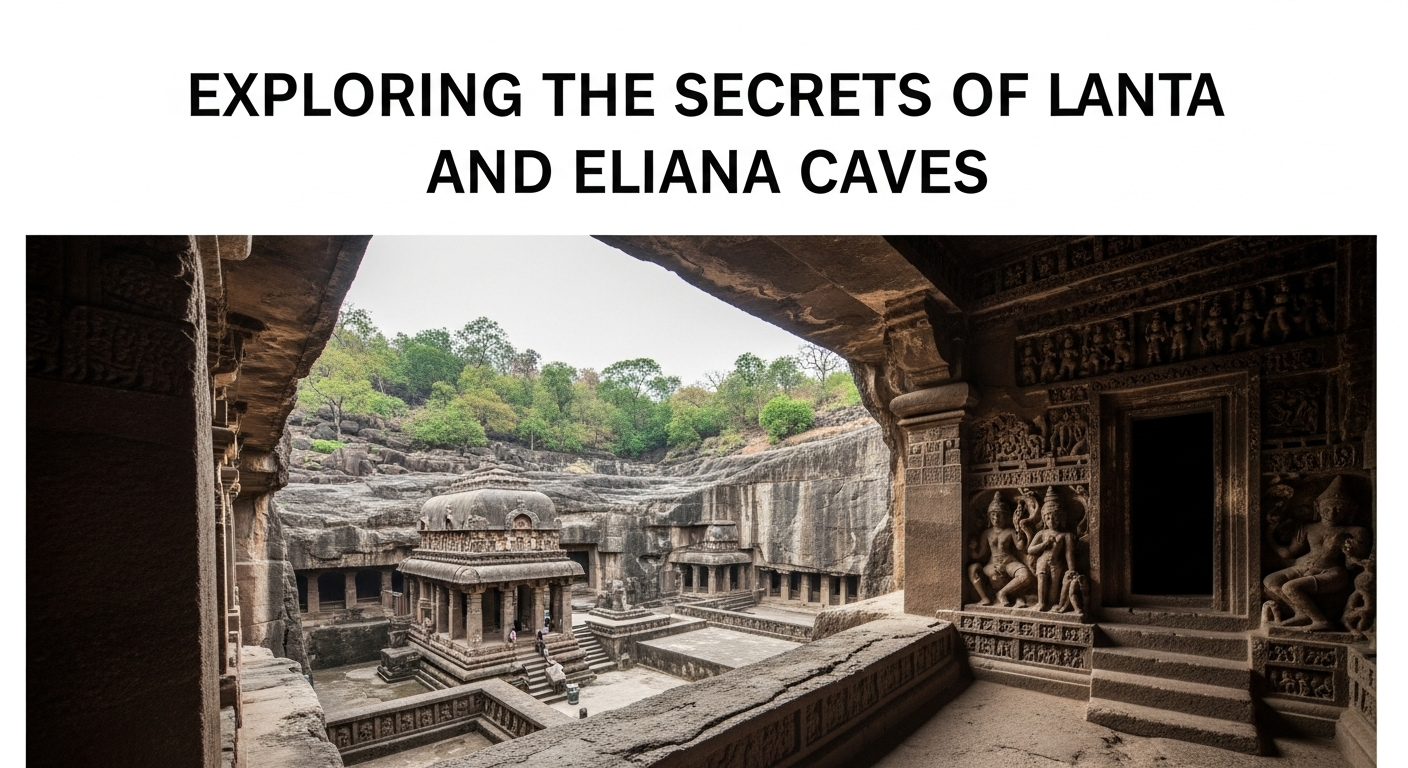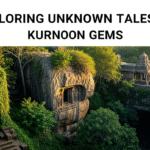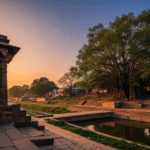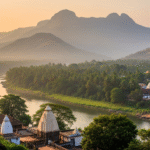In Maharashtra, the Ajanta and Ellora caves are truly amazing. They show India’s rich past. They have been around since the 2nd century BCE. These sites are protected by UNESCO. They tell stories of Buddhism, Hinduism, and Jainism. Their carvings and paintings are stunning. The Ajanta and Ellora caves are a great place to visit. They tell an important part of India’s history.
The Ajanta caves show the peaceful life of Buddhist monks. They have beautiful paintings and sculptures. It feels like an art place and a place for quiet thought. On the other hand, the Ellora caves show devotion to many gods. This includes the incredible Kailasa Temple, made from just one rock. If you love ancient stories, visiting these caves is like a special journey. It takes you deep into India’s spiritual and creative past.
Key Takeaways
- Visitors learn about India’s religious history at the Ajanta and Ellora caves.
- These caves are an important travel spot and part of India’s history.
- As UNESCO sites, they help us understand ancient Indian art and faith.
- Ellora’s Kailasa Temple is a marvel because it’s carved from a single rock.
- At Ajanta, murals beautifully tell stories of Buddhist beliefs and life.
- Exploring these caves feels like a journey through time.
An Unveiling of the Ancient Marvels
The Ajanta and Ellora caves are full of historical significance. They show us stunning ancient architecture and Buddhist art. These cave temples were carved into hillsides. They show the hard work and love of their makers.
These caves are in Maharashtra’s green lands. They are not just architectural wonders. They also highlight artistic styles merging over time. To learn more about Maharashtra’s architecture, check out the diverse architectural styles of Maharashtra.
| Cave | Location | Discovery Date | Significant Feature |
|---|---|---|---|
| Ajanta | Maharashtra, India | 2nd century BCE | 30 Rock-Cut Buddhist Monuments |
| Ellora | Maharashtra, India | 6th century CE | 34 caves depicting religious harmony |
| Škocjan Caves | Slovenia | 19th century | Large underground canyon |
| Lascaux Caves | France | 1940 | Paleolithic cave paintings |
| Altamira Cave | Spain | 1868 | Prehistoric art dating back 36,000 years |
These places let us see into past lives. We learn about ancient religions and art from them. The historical significance of Ajanta and Ellora is huge. They show spiritual and artistic effort across time.
The Historical Tapestry of Indian Rock-Cut Architecture
The rock-cut caves of India are important. They include the famous Ajanta and Ellora caves. These places tell stories through stone about India’s past and religion.
They are carved from solid rock. This shows India’s skill in making cave temples long ago.
The caves are not just art. They are tied to religion too. Ajanta is known for its Buddhist art. Ellora combines Hindu, Jain, and Buddhist styles. This mix shows India’s diverse faiths.
The Emergence of Cave Temples Throughout Centuries
Cave temples are a big part of Indian architecture. They changed a lot over time. At first, they were simple shelters.
Later, they became big like the ones in Ajanta and Ellora. These places were made for worship and peace, away from the busy world.
Intersecting Faiths: A Mosaic of Religious Expression
The Ellora and Ajanta caves are special. Ellora has 34 caves, each one different. They show how Buddhism, Hinduism, and Jainism can be together in one place.
This mix of faiths is very important. It shows how India values religious harmony. It gives us a look into the spiritual life of old India.
| Cave Number | Name and Dedication | Religious Influence |
|---|---|---|
| 10 | Vishwakarma (Buddhist) | Buddhism |
| 16 | Kailasa Temple (Hindu) | Hinduism |
| 32 | Indra Sabha (Jain) | Jainism |
The caves’ designs show hard work and respect for different religions. They hold a key place in India’s history. People from all over come to see these caves and learn their secrets.
Secrets of Ajanta and Ellora Caves: A Legacy Carved in Stone
The Secrets of Ajanta and Ellora caves show us India’s rich history. At this UNESCO World Heritage site, we see art and faith from long ago. These old caves are in Maharashtra’s hills. They show how people in early Indian civilizations lived and what they believed. This tells us how important they are in history.
Every cave at Ajanta and Ellora tells stories of India’s various faiths. The Ajanta caves have colorful wall paintings. The Ellora caves have the big Kailasa temple. All the art and carvings show India’s rich religious past. Every piece of art tells a unique story of old traditions. They have been kept safe for thousands of years.
- The historical and cultural stories seen in Ajanta’s 30 rock-cut Buddhist caves.
- The beauty and vast spiritual views in the Ellora Caves. They have Buddhist, Hindu, and Jain monuments side-by-side.
| Feature | Description | Number/Distance |
|---|---|---|
| Total UNESCO Sites | Visited during Tour | 2 (Ajanta & Ellora Caves) |
| Notable Monument in Ellora | Kailasa Temple dedicated to Lord Shiva | Cave 16 |
| Distance to Ajanta from Aurangabad | Proximity to major town | 105 km |
| Distance to Ellora from Aurangabad | Proximity to major town | 30 km |
We keep learning and saving these old special places. We keep alive India’s ancient art and spiritual talks. The Secrets of Ajanta and Ellora caves at this UNESCO World Heritage site show us human creativity and religious tolerance. They prove how special and important these caves are in history.
The Artistic Genius Behind the Buddhist Murals of Ajanta
The Ajanta caves are a breathtaking reflection of ancient Buddhist art. They are known for their intricate murals. These caves show the art and culture of Buddhism, offering a look into Buddha’s life and teachings. The mix of deep spirituality and art makes Ajanta a key part of India’s heritage.
A Colorful Window into Ancient Buddhist Society
In the valleys of Maharashtra, the Ajanta caves show beautiful ancient paintings. These paintings tell stories from the Buddha’s life. They reflect the society of that time, showing daily life, festivals, and royal gatherings. These murals help scholars learn about ancient Buddhist communities’ customs and clothes.
Preservation of Precious Frescoes: Techniques and Challenges
Preserving the Ajanta cave artworks is important but hard. Things like weather, people, and time have damaged these old treasures.
Preservation methods have changed over time. Now, they use science and work with experts worldwide. This helps keep the frescoes’ original spirit while fixing them.
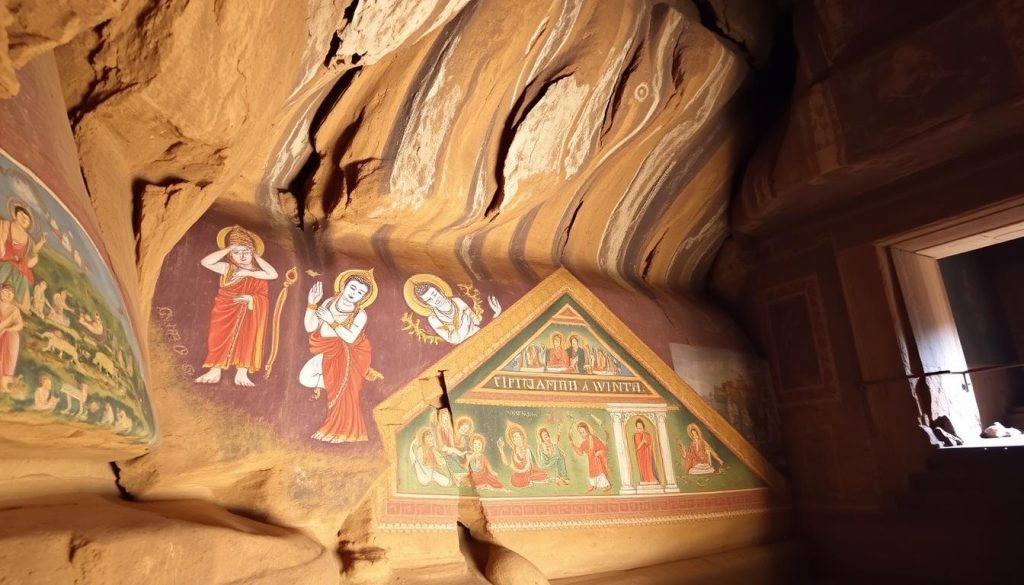
| Year | Preservation Activity | Impact |
|---|---|---|
| 1998 | Climate Control Installation | Significant reduction in moisture-induced damage |
| 2005 | Introduction of Visitor Limitations | Decrease in physical wear and tear from tourism |
| 2015 | Advanced Digital Imaging | Non-intrusive documentation and analysis of frescoes |
| 2022 | Chemical Consolidation Techniques | Enhanced longevity of pigment and wall integrity |
The Kailasa Temple of Ellora: An Architectural Wonder
The Kailasa Temple is in the big Ellora caves. It shows the skill of its makers. Made from one rock, this temple is a top example of rock-cut architecture. It is one of the most amazing architectural wonders in India.
Made in the 8th century, the Kailasa Temple is for Lord Shiva. It is the biggest monolithic structure in the world. The builders started from the top and moved downward. This needed a lot of planning.
The temple has many beautiful carvings. These include gods, mythical creatures, and stories from Hindu books. It is a place for praying and shows great craftsmanship. It draws scholars, architects, pilgrims, and tourists from all over the world.
| Feature | Description |
|---|---|
| Dimensions | 164 feet in length, 108 feet in width, and 100 feet in height |
| Construction Volume | 150,000 to 200,000 tons of solid rock removed |
| Ancient Techniques | Vertical excavation from the top of the rock downward |
| Symbolism | Dedicated to Lord Shiva; symbolizes Mount Kailash |
| Cultural Significance | Epitome of Rashtrakuta architecture and cosmic mountain that represents the abode of Lord Shiva |
A lot of rock was removed to build the Kailasa Temple. The detailed carvings show its uniqueness. This temple is a lasting sign of ancient Indian art and spirituality.
Ajanta’s Monastic Cells: Sanctuaries of Serenity and Study
The Ajanta Caves are a UNESCO World Heritage Site in Maharashtra. They are famous for their Buddhist monastic cells. These cells show a deep commitment to meditation and spiritual work. They were not just homes but centers for daily spiritual activities.
The Routine of Buddhist Monks Revealed through Ruins
The monks had a structured life focused on spiritual practices. The cells’ design helped them meditate. Their simple, calm design made a peaceful place. This helped monks have deep spiritual experiences.
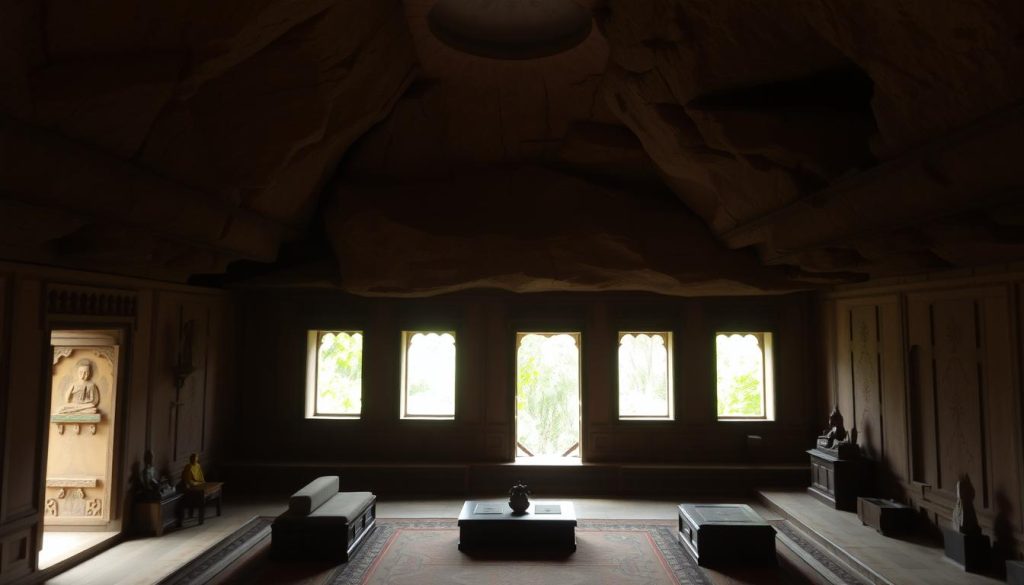
Meditative Spaces Designed for Enlightenment
Each cell was made to aid meditation. The caves’ calm and the monks’ chants made a devoted, thoughtful atmosphere. The cells’ design and placement aimed to get the best energy and light for meditation.
| Year | UNESCO World Heritage Sites Added | Site Type |
|---|---|---|
| 1983 | Ajanta Caves, Ellora Caves, Taj Mahal | Cultural |
| 2021 | Dholavira, Kakatiya Rudreshwara (Ramappa) Temple | Cultural |
| 1983-2021 | Total Sites Added | 41 |
The Ajanta Buddhist monastic cells are more than old relics. They inspire spiritual practices today. They attract people seeking peace and understanding, which is needed in our busy lives.
Ellora: A Syncretic Junction of Hindu, Buddhist, and Jain Pilgrimage
The Ellora caves are a mix of Hinduism, Buddhism, and Jainism. This mix shows the area’s rich culture and old India’s diverse beliefs. Many pilgrims visit, showing it’s important for different religions.
Each religion at the Ellora caves shows its own ideas and art. Visitors can see different beliefs side by side. This lets everyone learn how these religions lived together peacefully.
| Cave Number | Dedicated To | Highlights |
|---|---|---|
| 10 | Buddhism | Vishvakarma Cave – Chaitya Hall with a spectacular Buddha statue |
| 16 | Hinduism | Kailasa Temple – World’s largest monolithic structure |
| 32 | Jainism | Indra Sabha – Detailed carvings depicting Jain Tirthankaras |
The Ellora caves are very special for spiritual trips. They teach about Hinduism, Buddhism, and Jainism. This place shows how India values many spiritual paths. It’s a guide for visitors today who want to understand these three religions.
Deciphering the Ellora Caves: Iconography and Devotion
The Ellora Caves are amazing examples of ancient India’s temples. They show us the spiritual and artistic work of people long ago. The caves have religious carvings and Hindu images that tell stories of faith and myths. These were made by skilled workers centuries ago.
Understanding Hindu Deities and Iconography
At the Ellora caves’ heart, we see deep meanings of Hindu belief through many deities and symbols. Each statue and carving shares big ideas about philosophy and theology. In the Ellora Caves, Hindu images show gods and goddesses. They are important for understanding life and spirituality.
The Monolithic Masterpiece: Interpreting Religious Carvings
The Ellora caves, especially the Kailasa Temple, show the peak of rock-cut architecture. The sculptures celebrate the art of carving from a single stone. They show a strong dedication to religion and art.
Every scene in the caves tells a story. Each figure is made with care, giving life to stone. The faces and forms of gods and mythical creatures show famous Indian stories. They help us see what the artists were thinking.
| Feature | Details |
|---|---|
| Carving Technique | Chiseled from solid basalt rock, showcasing detailed expressions and intricate attires. |
| Main Deities Represented | Shiva, Vishnu, and Devi depicted in various forms, embodying different aspects and narratives. |
| Architectural Influence | Reflects a blend of Buddhist, Jain, and Hindu elements, indicating a period of religious tolerance and artistic exchange. |
| Historical Significance | Thought to be constructed between the 6th and 10th centuries, marking a prolific period in Indian rock-cut architecture. |
| Cultural Impact | Served as important religious sites that attracted pilgrims, scholars, and artists, enriching the cultural fabric of medieval India. |
In looking closely at these carvings and Hindu images at Ellora, we find deep spiritual stories. They connect the past and the present in powerful ways. The Ellora caves stand as a big symbol of art and religion in Indian history.
Peeling Back Centuries: Preservation Efforts at Ajanta and Ellora
The Ajanta and Ellora caves are true wonders, showing ancient Indian art and architecture. They amaze scholars and tourists from around the world. Keeping these historic treasures safe blends old techniques with new science. This mix is key to saving the art and culture at these sites.
Ajanta is famous for its beautiful murals, but they are at risk due to humidity and people visiting. Ellora has many carved temples and suffers from erosion and old restorations going wrong. Both places face unique challenges.
- Teams check the caves often. They fix places that need help the most.
- They limit visitors and use special lights to stop more damage.
- Conservationists use careful methods to clean and fix artifacts without harming them.
Help also comes from around the globe. Experts bring their skills and technology to these sites. This worldwide effort shows how important it is to protect Ajanta and Ellora for everyone.
| Challenge | Ajanta | Ellora |
|---|---|---|
| Primary Environmental Threat | Humidity causing damage to murals | Erosion and structural damage from natural elements |
| Human Impact | Charred by carbon dioxide and physical touch from tourists | Alterations from earlier archaeological methods |
| Preservation Approach | Use of microclimate control and visitor management | Structural reinforcements and controlled excavations |
| International Contribution | Collaborations for chemical conservation treatments | Technical support for structural assessments |
Our efforts keep the Ajanta and Ellora caves alive as teaching and inspiring heritages. By careful conservation, we make sure these windows to ancient India stay bright. We protect the spirit of human creativity and devotion set in stone.
Traversing the Caves: A Traveler’s Guide to Ajanta and Ellora
For those keen on exploring Ajanta and Ellora, a good travel guide is key. These amazing caves take you back in time with their history and art. Planning well can make your visit even better.
Planning Your Visit: Must-See Caves and Their Hidden Stories
Choosing which caves to see at Ajanta and Ellora is important. Each cave tells a different story of old rituals and lost civilizations. Here are some tips to help you get the most out of your visit:
- Ajanta Caves: Begin with Cave 1 for its bright paintings and sculptures. Cave 26 is also a must-see for its impressive chaitya hall and sleeping Buddha.
- Ellora Caves: Don’t miss the Kailasa Temple in Cave 16. This huge stone temple is a wonder of old engineering and art.
Tips for a Fulfilling Journey Through Time
Visiting these historic places is a trip back in time. To fully enjoy it and honor its history, here are some tips:
- Start your tour early to avoid crowds and heat.
- Wear shoes that are comfortable for uneven ground.
- Bring water and snacks to stay hydrated as you explore.
- A local guide can tell you the fascinating stories behind the art and sculptures.
Treat these ancient sites with respect. Remember the cultural and spiritual importance they have. It’s a journey through history and India’s past art and spirituality.
| Item | Visiting Tip |
|---|---|
| Best time to visit | October to March, for pleasant weather and clear paths |
| Travel Essentials | Comfortable footwear, water, snacks, camera |
| Local Guides | Available for hire at site entrances |
| Respect for Site | Avoid touching painted walls and sculptures |
By following these tips for exploring Ajanta and Ellora, your guide will become more alive. Your tour will be richer and with respect. The caves are not just big landmarks but sacred places. They help us understand a world long gone.
Conclusion
The journey through the Ajanta and Ellora caves is more than just a trip. It’s a deep dive into India’s past. These caves, totaling 63 in Maharashtra, are not just old marvels. They are stories of religious harmony, with temples for Buddhists, Hindus, and Jains. They are known worldwide for their history and as amazing travel spots for culture lovers.
The Ellora caves, with 34 temples, are stunning because of their size and the work it took to make them. The Kailasa temple is especially awe-inspiring. Meanwhile, the Ajanta caves let you peek into the lives of ancient Buddhist monks. Since 1983, they’ve been a UNESCO World Heritage Site. They also host the yearly Ellora Festival of Classical Dance and Music, making them a lively place to visit.
Across India, from Mumbai’s Elephanta Caves to Andhra Pradesh’s Belum Caves, each site has its charm. They invite travelers to see their beauty, from the Bhimbetka Rock Shelters to the caves of Udayagiri and Khandagiri. India’s caves show the spiritual side of its ancient culture. For those who visit, these caves offer a journey through history and art that has lasted for centuries.
FAQ
What are the Secrets of Ajanta and Ellora Caves?
The secrets of Ajanta and Ellora caves lie in their ancient architecture and art. They show us beautiful Buddhist art and tell us about India’s history. People visit these caves to see a UNESCO World Heritage site and learn about India’s culture.
Why are Ajanta and Ellora caves significant?
The Ajanta and Ellora caves are important because they show ancient rock-cut architecture. They display the art and culture of Buddhist, Hindu, and Jain traditions. These caves prove ancient Indian artisans’ skill and their spiritual devotion.
How have the Ajanta caves contributed to our understanding of Buddhist art?
The Ajanta caves help us understand Buddhist art thanks to their murals and frescoes. These paintings show the life of Buddha and ancient Indian life. They provide insights into cultural and religious practices from long ago.
What is the architectural significance of the Kailasa Temple in Ellora?
The Kailasa Temple in Ellora is known for being carved from one single rock. This shows advanced engineering and the incredible skill of ancient artisans. It highlights the effort and skill that went into its making, making it a remarkable cave temple.
How were the monastic cells in the Ajanta caves used?
The monastic cells in Ajanta were used by Buddhist monks for peace and study. They were designed for meditation and enlightenment. These cells provided a calm place for spiritual practices.
What makes Ellora a unique pilgrimage site for different religions?
Ellora is special because it welcomes Hindu, Buddhist, and Jain faiths. Its caves show the peaceful coming together of these religions. This reflects the blend of cultures in ancient India.
How is the iconography in the Ellora caves important?
The Ellora caves’ iconography teaches us about Hindu gods and stories through carvings. The sculptures and relief works tell us Hindu myths. They help us understand ancient devotional practices and art.
What preservation efforts are being made for Ajanta and Ellora caves?
Efforts to preserve the Ajanta and Ellora caves focus on keeping the carvings, frescoes, and structures safe. They protect the site from damage and human touch. This ensures these treasures last for more generations.
What should a traveler prepare for when visiting Ajanta and Ellora caves?
Visitors should learn about the caves’ history and culture before going. Wear comfy shoes and drink water. Start early to see everything. Using guides and respecting the caves is also good advice.
Can the Ajanta and Ellora caves be considered a prime travel destination?
Yes, the Ajanta and Ellora caves are a top spot for exploring ancient and spiritual places. Being UNESCO sites, they draw people globally. Visitors come to experience the historical and cultural stories of India.
